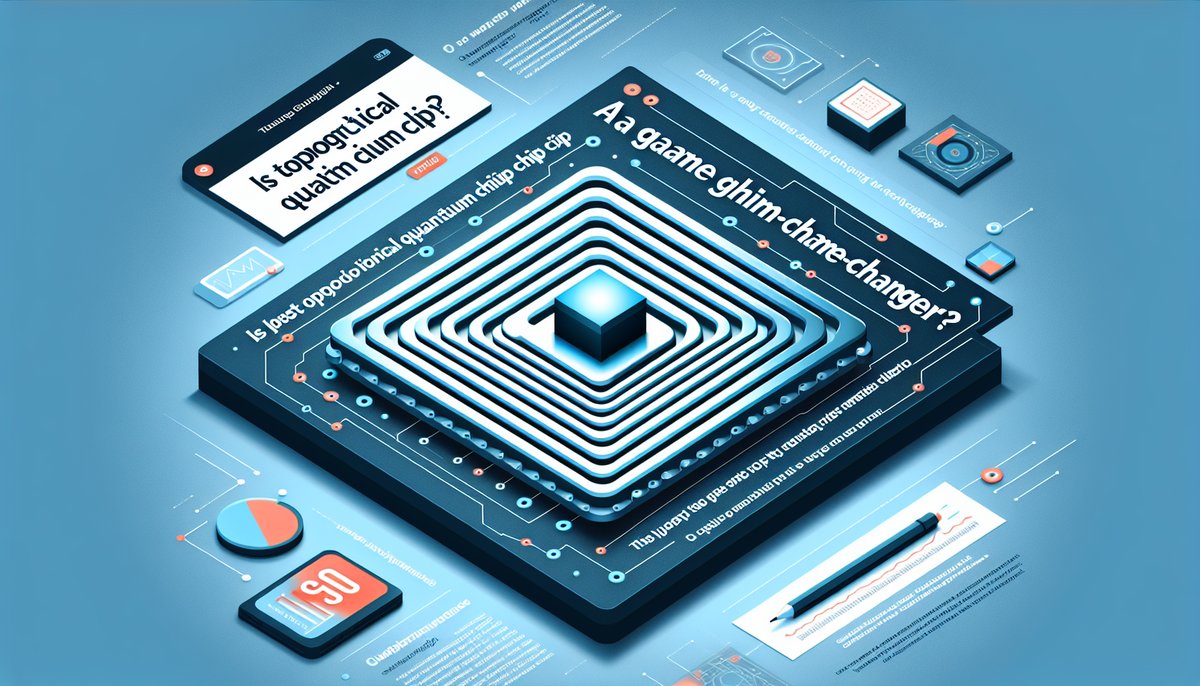Is Microsoft's Topological Quantum Chip a Game-Changer?

Introduction: The Quantum Computing Revolution
Microsoft’s recent unveiling of the Majorana 1 quantum chip marks a pivotal moment in the evolution of quantum computing. With claims of a scalable design based on a Topological Core architecture, this breakthrough has the potential to propel quantum hardware into real-world applications far sooner than many experts anticipated. In this article, we delve deep into the technology behind Microsoft’s novel approach, explore what topological qubits mean for error correction and scalability, and assess how this development fits into the broader landscape of emerging programming trends and advanced computing frameworks.
Breaking Down Microsoft's Majorana 1 Chip
At the heart of Microsoft’s announcement is the Majorana 1 chip. Unlike traditional quantum processors that rely on conventional qubit implementations, this chip employs a topological superconductor—a material that not only conducts electricity without resistance under certain conditions but also supports a novel quantum state of matter. This state, predicted over a century ago by the mathematician Ettore Majorana, provides a robust platform for forming qubits which are less susceptible to the decoherence and noise that plague classical quantum systems.
Understanding Topological Quantum Computing
Before diving further into the Majorana 1 chip’s innovative design, it’s essential to understand the fundamental concepts behind topological quantum computing. In traditional quantum systems, qubits can exist in a superposition of states; however, this very characteristic makes them highly vulnerable to environmental disturbances. Topological quantum computing leverages the mathematical properties of certain materials to create qubits that are naturally protected from local disturbances, thereby potentially reducing the overhead required for quantum error correction.
Scalability: The Road to a Million Qubits
One of the most significant challenges in the field of quantum computing is scalability. Commercially useful quantum computers are expected to require millions of physical qubits. Present-day innovations from companies like Google and IBM have demonstrated processors with qubit counts in the low hundreds, but these systems fall short of being practically scalable.
Microsoft’s topological design presents a promising solution. The Majorana 1 chip, although currently featuring eight topological qubits, is engineered with scalability in mind. The company believes that its Topological Core architecture is the key to creating a chip that supports up to a million qubits. By reducing the complexity of quantum error correction, Microsoft aims to avoid the pitfalls of needing vast, impractical physical infrastructures and instead achieve meaningful quantum computation within existing data center environments like Azure.
Quantum Error Correction and Its Challenges
Quantum error correction is one of the biggest hurdles on the path toward large-scale quantum computing. In most quantum systems, physical qubits are highly error-prone, necessitating the use of many more physical qubits to produce a stable logical qubit that can reliably perform computations. Microsoft’s approach counters this by using topological qubits, which inherently require less error correction due to their resistance to certain types of noise.
Key benefits of this approach include:
- Inherent Stability: Topological states are more robust against local perturbations.
- Simplified Error Correction: Fewer physical qubits are needed per logical qubit, paving the way for more compact designs.
- Integration Potential: The chip’s design is tailored for integration in existing high-density data centers, making the transition to practical quantum computers smoother.
The Role of Novel Materials: Indium Arsenide and Topoconductors
Unlike silicon chips used for classical computing, the Majorana 1 chip is built using indium arsenide—a material prized for its infrared detection capabilities and superconducting properties at extremely low temperatures. But what sets this material apart is the formation of a topoconductor. A topoconductor is a new type of semiconductor that also acts as a superconductor, a phenomenon that was once relegated to theoretical physics. The existence and control of the Majorana fermion in this context not only validates long-standing predictions but also opens new avenues for developing quantum hardware that is both efficient and scalable.
Implications for Quantum Programming and Software Development
Beyond the hardware breakthroughs, Microsoft's innovation carries profound implications for the software side of quantum computing. The advent of a more scalable quantum chip calls for a rethinking of quantum programming paradigms and the development of new coding frameworks suited for hybrid classical-quantum computation.
Developers and researchers in the quantum space are already exploring:
- New Quantum Algorithms: Algorithms that can leverage the enhanced stability of topological qubits to solve complex problems in cryptography, materials science, and beyond.
- Hybrid Frameworks: Integrating classical computing with quantum processors to achieve higher efficiency in tasks where quantum advantage is most pronounced.
- Emerging Programming Languages: Languages and toolkits specifically designed for quantum computing, such as Q# from Microsoft, which are evolving to harness the capabilities of advanced quantum hardware.
Emerging Trends in Quantum Software and AI-Driven Coding
As quantum computing continues its rapid evolution, we are also seeing a reemergence of interest in AI-driven coding and low-code/no-code innovations within this space. By leveraging artificial intelligence, developers can automate aspects of quantum algorithm design, optimize error correction protocols, and predict performance issues before they become critical obstacles.
Key trends include:
- Quantum-AI Synergy: AI is increasingly being used to simulate quantum circuits and optimize their performance, thus accelerating research and development.
- Toolchain Evolution: New integrated development environments (IDEs) tailored for quantum software development are emerging, helping researchers test and deploy quantum applications more efficiently.
- Collaborative Platforms: Cloud-based platforms like Microsoft Azure Quantum are fostering collaboration among researchers, developers, and enterprises to pool resources and accelerate breakthroughs.
Adapting to a New Era of Computing
The promise of quantum computing is not just a theoretical exercise. The development of a scalable quantum chip directly impacts industries ranging from pharmaceuticals to finance. By solving complex simulations and cryptographic challenges that are currently intractable, quantum computers have the potential to disrupt conventional computing paradigms.
For programmers and tech professionals, the key takeaways are:
- Upskilling: Becoming proficient in quantum programming languages and frameworks is becoming increasingly important. Courses in quantum mechanics and algorithm design are now more relevant than ever.
- Cross-Disciplinary Collaboration: Bridging the gap between theoretical physics and software development can lead to innovative solutions and breakthroughs.
- Adaptive Mindset: As industries transition to hybrid classical-quantum computing, staying agile and informed about emerging trends will be crucial for success.
Challenges on the Road Ahead
While Microsoft’s Majorana 1 chip is an exciting advancement, significant challenges remain. Scalable quantum computing is still in its nascent stages, and practical deployment will require overcoming several technical and engineering hurdles:
- Temperature Requirements: Quantum chips operate at extremely low temperatures, necessitating sophisticated cooling solutions.
- Materials Engineering: Manufacturing consistency for novel materials like indium arsenide, and ensuring the reliable formation of topoconductors, is non-trivial.
- Integration with Classical Systems: Creating a seamless interface between quantum processors and classical computing infrastructures remains a key challenge.
- Standardization: The lack of standardized protocols across quantum computing platforms can hinder widespread adoption and cross-platform compatibility.
Future Research and Industry Impact
The innovations presented by Microsoft are likely to fuel further research into topological quantum computing. Collaborative efforts with government agencies like DARPA and partnerships with academic institutions hint at a future where quantum breakthroughs are not confined to labs but are translated into practical, scalable solutions.
Future research will focus on:
- Optimizing Qubit Stability: Refining the materials and architecture to further reduce error rates and enhance qubit coherence times.
- Integrative Solutions: Developing hardware that seamlessly integrates with cloud platforms, paving the way for accessible quantum computing as a service.
- Expanding Quantum Algorithms: Encouraging the creation of new algorithms that can fully exploit the potential of topological qubits.
Conclusion: A New Dawn for Quantum Computing
Microsoft’s announcement of the Majorana 1 quantum chip is more than just a technological milestone—it’s a glimpse into the future of computing. By harnessing the unique properties of topological qubits and novel materials, this breakthrough could accelerate the journey toward practical, scalable quantum computers. For developers, tech professionals, and researchers alike, this development represents both an opportunity and a challenge: to adapt to a rapidly evolving landscape while contributing to the next era of computational innovation.
As the quantum computing race heats up, keeping abreast of emerging trends, learning new quantum programming languages, and understanding the underlying physics will be crucial for those looking to make an impact. With advances such as Microsoft’s Topological Quantum Chip, the future of quantum computing is not only on the horizon—it is becoming a tangible reality.
Stay tuned as we continue to explore how these innovations reshape industries, redefine computing standards, and inspire new approaches in software development and quantum research.



Comments ()